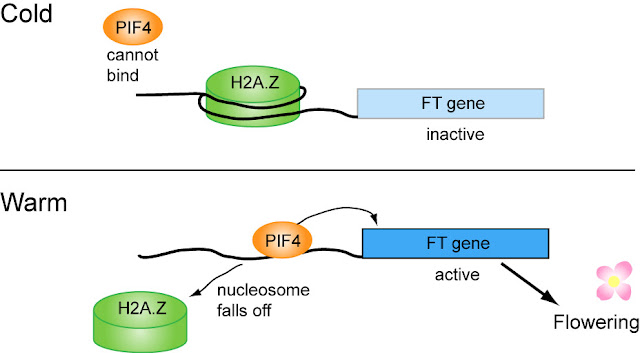Remember a month ago, before the rains started, when it was warm and sunny and all the trees in Berkeley were blooming? The Magnolias and plum trees were particularly beautiful.
 |
| From Berkeleyside blog |
How do the plants know that it’s warm and time to bloom? Plants can sense day length and will begin to grow and bloom when the length of sunlight increases in spring. Our trees were blooming in January and February, though, so plants must also be able to sense temperature changes too. This week’s paper addresses the molecular changes that occur to induce flower growth in response to warmer temperatures, even when the daylight is still reduced in winter. The paper by Kumar et al. was published online in Nature.
The transcription factor PIF4
The authors focused their studies on a protein called PIF4. This protein binds to DNA and helps direct gene expression (or transcription), which makes it a transcription factor. In normal, wildtype Arabidopsis plants, there is early flowering at warm temperatures, but in mutants that do not have PIF4, flowering is delayed. In contrast, when PIF4 is overexpressed, early flowering is induced. These results show that flowering at warm temperatures depends on PIF4.
The authors go on to show that PIF4 binds DNA just upstream of a gene called FT, which is necessary for flowering. One can imagine a simple pathway where higher temperatures induce PIF4 to bind to the FT gene and activate gene expression. Increased FT then initiates cellular pathways that signal the plant to go into bloom.
How do increased temperatures increase PIF4 binding to the FT gene?
1) Maybe high temperatures increase transcription of PIF4. The authors measure RNA levels of PIF4 at different temperatures and find that there is more expression at higher temperatures, but not enough to account for the extreme differences in flowering.
2) Maybe high temperatures make the protein more stable. In this case you would expect to see less PIF4 protein at cold temperatures, but the authors find that protein levels are unchanged by temperature.
3) Do high temperatures help the binding interaction between PIF4 and FT? Yes, there is more PIF4 bound to FT at higher temperatures, but why?
Nucleosome H2A.Z
In past posts, I’ve talked about histones in the context of epigenetics. DNA wraps around histone proteins to help pack the DNA into a smaller package. The collection of histones that DNA wraps around is called a nucleosome. When DNA is wrapped around nucleosomes, other proteins cannot bind to the DNA and gene expression doesn’t happen. There is a nucleosome called H2A.Z that binds near the FT gene in the same place where PIF4 needs to bind. Therefore, when the nucleosome is present, PIF4 cannot bind and activate expression of FT and there will be no flowering. H2A.Z binding to FT is temperature dependent in the exact way you would expect. In cool temperatures, H2A.Z binds FT DNA, so PIF4 cannot bind and FT will not be expressed. In warm temperatures, for whatever reason, the H2A.Z nucleosome comes off of the DNA, allowing PIF4 to bind.
 |
| Adapted from Figure 4C of Kumar et al., 2012, Nature. |
It’s nice when there is a relatively simple molecular explanation for something we observe in the environment all the time. This subject is also important because global warming will continue to induce earlier and earlier flower blooming, which could be detrimental to food crops.
No comments:
Post a Comment